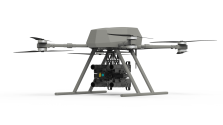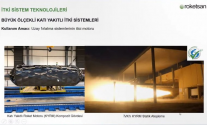STM develops 'Anti-Radiation KARGU UAV'
The anti-radiation version of the KARGU Striking Unmanned Aerial Vehicle developed by STM is coming. KARGU Anti-Radiation will be effective against radar systems.
The anti-radiation version of the KARGU Striker Unmanned Aerial Vehicle, which was developed by STM with national means and is currently actively used especially in anti-personnel missions, is being developed. Speaking at the 9th Defense Industry Days event organized by YTU Machinery Technologies Club, STM Autonomous Platforms Group Manager Erhan ÖZTÜRK announced that the anti-radiation KARGU will be on the field in 2022.
In the statement made by ÖZTÜRK, “What we call Anti-Radiation is actually an ability to be directed to an anti-radiation source. So let's say you are in an environment without GPS and there is an RF source in this environment without GPS; this may be a radar system or a jammer system. There is a work like locking on to this, navigating there without navigation aids such as GPS. Prototypes of this have been made, and I can say when it will be released in 2022. Let me not go into more detail right now. " His statements were included.
Currently, STM is managing a project called KERKES to enable platforms such as KARGU to operate in non-GPS environments. The KERKES Project, initiated by the Presidency Defense Industry Presidency, is directly related to Anti-Radiation KARGU.
KARGU
KERKES Project
Within the scope of Global Positioning System Independent Autonomous Navigation System Development (KERKES) Project, STM aims to enable rotary-wing (multi-rotor) and fixed-wing UAVs to operate in non-GPS environments.
In project scope;
Feature extraction algorithms,
Certain point recognition algorithms,
Artificial intelligence and machine learning algorithms will be developed.
In addition, with the Kerkes Project, it is aimed to gain the following capabilities;
Position estimation without GPS
Mission execution without GPS
Navigation with object recognition and deep learning
KARGU Strike UAV Features
KARGU-Strike-UAV
Range: 5,10 km
Duration: 30 minutes
Mission Altitude: 500 meters
Maximum Altitude: 3,000 meters (MSL)
Warhead: 1.3 kg
Dimensions: 707mm x 707mm x 404mm
Weight: 7.060 grams
Temperature: -20 / + 50 ° C
The anti-radiation version of the KARGU Striking Unmanned Aerial Vehicle developed by STM is coming. KARGU Anti-Radiation will be effective against radar systems.
The anti-radiation version of the KARGU Striker Unmanned Aerial Vehicle, which was developed by STM with national means and is currently actively used especially in anti-personnel missions, is being developed. Speaking at the 9th Defense Industry Days event organized by YTU Machinery Technologies Club, STM Autonomous Platforms Group Manager Erhan ÖZTÜRK announced that the anti-radiation KARGU will be on the field in 2022.
In the statement made by ÖZTÜRK, “What we call Anti-Radiation is actually an ability to be directed to an anti-radiation source. So let's say you are in an environment without GPS and there is an RF source in this environment without GPS; this may be a radar system or a jammer system. There is a work like locking on to this, navigating there without navigation aids such as GPS. Prototypes of this have been made, and I can say when it will be released in 2022. Let me not go into more detail right now. " His statements were included.
Currently, STM is managing a project called KERKES to enable platforms such as KARGU to operate in non-GPS environments. The KERKES Project, initiated by the Presidency Defense Industry Presidency, is directly related to Anti-Radiation KARGU.
KARGU
KERKES Project
Within the scope of Global Positioning System Independent Autonomous Navigation System Development (KERKES) Project, STM aims to enable rotary-wing (multi-rotor) and fixed-wing UAVs to operate in non-GPS environments.
In project scope;
Feature extraction algorithms,
Certain point recognition algorithms,
Artificial intelligence and machine learning algorithms will be developed.
In addition, with the Kerkes Project, it is aimed to gain the following capabilities;
Position estimation without GPS
Mission execution without GPS
Navigation with object recognition and deep learning
KARGU Strike UAV Features
KARGU-Strike-UAV
Range: 5,10 km
Duration: 30 minutes
Mission Altitude: 500 meters
Maximum Altitude: 3,000 meters (MSL)
Warhead: 1.3 kg
Dimensions: 707mm x 707mm x 404mm
Weight: 7.060 grams
Temperature: -20 / + 50 ° C


